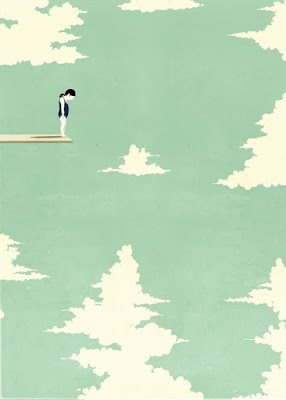"Draw with your head
not with your hand"
- Guido Scarabottolo
That, above, is Shout’s favorite quote and the reason why I chose to take a closer look at his work. Alessandro Gottardo is a contemporary Italian illustrator that works in Milan. He was born in Pordenone, Italy, in 1977, studied at a specialist art high school in Venice, and attended the Istituto Europeo di Design in Milan. He has won numerous awards including the gold medal from The Society of Illustrators New York in 2009.
Thinking back to why I decided to take this drawing class, I realized the core reason was getting practical training that could contribute to my graphic design workflow. Not surprisingly, when going through the NC section of the Lily Library stacks, the 100 Illustrators book immediately called my attention. Hence, for this assignment, I decided to take a different take on the traditional definition of ‘artist’ and chose someone inside what some would consider the ‘applied art’ realm instead of the ‘fine art’ realm (Hall, 2011). Since Alessandro is currently working, there are not many sources that talk about him in retrospective or that analyze his style in a historical perspective (yet, there may be someday). Instead, I chose to dedicate this blog post to talk about illustration as an art and to display some of his amazing work.
"I started drawing
when I was a child"
— Shout
Just as it is hard to trace the dividing line between art and graphic design, it is hard to define the difference between drawing and illustration. Illustrators usually have a client’s needs in mind and they constantly strive to encapsulate an idea that communicates to an audience in an innovative way that is also articulate (Hall, 2011). Like Anita Kunz says, their goal is to make meaningful images that have the power to move people emotionally and intellectually (Brazell & Davies, 2011). Since I have been struggling with choosing themes for my drawings, it has been inspiring to look at exemplars from a field that centers its pieces around a message. Take a look, for example, at the following series of three illustrations that Shout did for Internazionale Magazine, an Italian publication.
 |
| Free Yourself 1 - Internazionale Magazine |
 |
| Free Yourself 2 - Internazionale Magazine |
 |
| Free Yourself 3 - Internazionale Magazine |
In an interview with My Modern Met, Alessandro explains how this series referenced a part of an article where “the writer talked about a little girl who was afraid of water, a sort of phobia; the psychologist suggested her to defeat her fear by jumping from a high trampoline.” These images are a reflection of Shout's narrative and minimalist style, as well as of his generous use of negative space (Heller & Wiedemann, 2013).
"I try to eliminate as many details as possible to get to an image’s core essence" — Shout
One of the major differences (although debatable) between graphic designers (including illustrators) and artists are the clients. Shout works for major newspapers and publications such as The New York Times, The Washington Post, The Wall Street Journal, Wired, and The Economist. The following is an illustration he did for the New York Times on the theme of the Arab Spring. He abstracts and translates the article Blood on the Nile into a visual piece.
 |
| Blood on the Nile - The New York Times |
 |
| Suicide Pill - Boston Magazine |
Suicide Pill, illustrated for Boston Magazine, works similarly. He plays with words and concepts transforming the message into a visual language.
"The void is my tool to isolate the heart of the message and make it more powerful" — Shout
 |
| A New Discovery - 3x3 Illustration Annual (Book Cover) |
 |
| Point of View - Personal piece |
Finally, in the above images we can see two of the most characteristic elements of Alessandro’s style: the contrast between light and shadow, as well as the interplay between full and empty. In an interview for VAV Magazine, Shout describes how the space around a character helps emphasize the message and allows for the spectator to fill in the gaps by interpreting the drawing. Alessandro mentions that every element the illustrator decides to place in the frame plays a specific role and can temper or exacerbate the tension created by the void space (Francesca, 2014).
Going back to the quote that started this post, I think the most important lesson that I learned from Shout is that, although the hand has to be well trained, drawing and illustration is also about the message and the idea behind what is going to be portrayed.
References:
- Alice, Y. (2010, October 27). More soft-spoken stories and interview with Shout. Retrieved March 2, 2016, from My Modern Met, http://www.mymodernmet.com/profiles/blogs/more-softspoken-stories-and
- Brazell, D., & Davies, J. (2011). The making great illustration. London: Bloomsbury USA Academic.
- Francesca. (2014). VAV #03 / shout + Olimpia Zagnoli / Intervista integrale. Retrieved March 2, 2016, from http://vavmagazine.com/n3/intervista-integrale.html
- Hall, A. (2011). Illustration. London: Laurence King Publishing.
- Heller, S., & Wiedemann, J. (Eds.). (2013). 100 illustrators. Germany: Taschen GmbH.
- Shout. Alessandro Gottardo. Retrieved March 2, 2016, from http://www.alessandrogottardo.com/
No comments:
Post a Comment